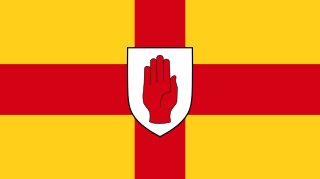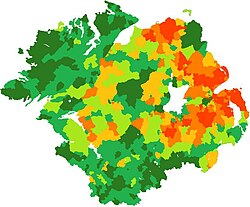
Northern Ireland is a part of the United Kingdom in the north-east of the island of Ireland that is variously described as a country, province or region. Northern Ireland shares an open border to the south and west with the Republic of Ireland. At the 2021 census, its population was 1,903,175, making up around 3% of the UK's population and 27% of the population on the island of Ireland. The Northern Ireland Assembly, established by the Northern Ireland Act 1998, holds responsibility for a range of devolved policy matters, while other areas are reserved for the UK Government. The government of Northern Ireland cooperates with the government of Ireland in several areas under the terms of the Belfast Agreement. The Republic of Ireland also has a consultative role on non-devolved governmental matters through the British–Irish Governmental Conference (BIIG).

Ulster is one of the four traditional or historic Irish provinces. It is made up of nine counties: six of these constitute Northern Ireland ; the remaining three are in the Republic of Ireland.

Anglo-Irish people denotes an ethnic, social and religious grouping who are mostly the descendants and successors of the English Protestant Ascendancy in Ireland. They mostly belong to the Anglican Church of Ireland, which was the established church of Ireland until 1871, or to a lesser extent one of the English dissenting churches, such as the Methodist church, though some were Roman Catholics. They often defined themselves as simply "British", and less frequently "Anglo-Irish", "Irish" or "English". Many became eminent as administrators in the British Empire and as senior army and naval officers since the Kingdom of England and Great Britain were in a real union with the Kingdom of Ireland for over a century, before politically uniting into the United Kingdom of Great Britain and Ireland in 1801.

Loyalism, in the United Kingdom, its overseas territories and its former colonies, refers to the allegiance to the British crown or the United Kingdom. In North America, the most common usage of the term refers to loyalty to the British Crown, notably with the loyalists opponents of the American Revolution, and United Empire Loyalists who moved to other colonies in British North America after the revolution.

Irish nationalism is a nationalist political movement which, in its broadest sense, asserts that the people of Ireland should govern Ireland as a sovereign state. Since the mid-19th century, Irish nationalism has largely taken the form of cultural nationalism based on the principles of national self-determination and popular sovereignty. Irish nationalists during the 18th, 19th, and 20th centuries such as the United Irishmen in the 1790s, Young Irelanders in the 1840s, the Fenian Brotherhood during the 1880s, Fianna Fáil in the 1920s, and Sinn Féin styled themselves in various ways after French left-wing radicalism and republicanism. Irish nationalism celebrates the culture of Ireland, especially the Irish language, literature, music, and sports. It grew more potent during the period in which all of Ireland was part of the United Kingdom, which led to most of the island gaining independence from the UK in 1922.
The Ulster Scots, also called Ulster Scots people or, in North America, Scotch-Irish (Scotch-Airisch) or Scots-Irish, are an ethnic group in Ireland who share a common history, culture, and ancestry. Some speak an Ulster Scots dialect of the Scots language, a West Germanic language. As an ethnicity, they descend largely from Scottish and English settlers who moved to the north of Ireland, during the 17th century.

Maghera is a small town at the foot of the Glenshane Pass in Northern Ireland. Its population was 4,235 in the 2021 Census. Formerly in the barony of Loughinsholin within the historic County Londonderry, it is today in the local-government district of Mid-Ulster.

The Plantation of Ulster was the organised colonisation (plantation) of Ulster – a province of Ireland – by people from Great Britain during the reign of King James VI and I. Most of the settlers came from southern Scotland and northern England; their culture differed from that of the native Irish. Small privately funded plantations by wealthy landowners began in 1606, while the official plantation began in 1609. Most of the land had been confiscated from the native Gaelic chiefs, several of whom had fled Ireland for mainland Europe in 1607 following the Nine Years' War against English rule. The official plantation comprised an estimated half a million acres (2,000 km2) of arable land in counties Armagh, Cavan, Fermanagh, Tyrone, Donegal, and Londonderry. Land in counties Antrim, Down, and Monaghan was privately colonised with the king's support.

The Irish Rebellion of 1641 was an uprising by Catholics in Ireland, whose demands included an end to anti-Catholic discrimination, greater Irish self-governance, and return of confiscated Catholic lands. Its timing was partially driven by the dispute between Charles I and his opponents—the English Parliamentarians and Scottish Covenanters—which the rebels feared would lead to an invasion and further anti-Catholic measures. Beginning as an attempted coup d'état by Catholic gentry and military officers, it developed into a widespread rebellion and ethnic conflict with English and Scottish Protestant settlers. It led to the 1641–1653 Irish Confederate Wars, part of the Wars of the Three Kingdoms, with up to 20% of the Irish population becoming casualties.

Plantations in 16th- and 17th-century Ireland involved the confiscation of Irish-owned land by the English Crown and the colonisation of this land with settlers from Great Britain. The Crown saw the plantations as a means of controlling, anglicising and 'civilising' Gaelic Ireland. The main plantations took place from the 1550s to the 1620s, the biggest of which was the plantation of Ulster. The plantations led to the founding of many towns, massive demographic, cultural and economic changes, changes in land ownership and the landscape, and also to centuries of ethnic and sectarian conflict. They took place before and during the earliest English colonisation of the Americas, and a group known as the West Country Men were involved in both Irish and American colonization.
Scotch-IrishAmericans are American descendants of Ulster Scots people who emigrated from Ulster to America during the 18th and 19th centuries. Their ancestors had originally migrated to Ulster mainly from the Scottish Lowlands and Northern England in the 17th century. In the 2017 American Community Survey, 5.39 million reported Scottish ancestry, an additional 3 million identified more specifically with Scotch-Irish ancestry, and many people who claim "American ancestry" may actually be of Scotch-Irish ancestry.

Ireland during the period of 1536–1691 saw the first full conquest of the island by England and its colonisation with mostly Protestant settlers from Great Britain. This would eventually establish two central themes in future Irish history: subordination of the country to London-based governments and sectarian animosity between Catholics and Protestants. The period saw Irish society outside of the Pale transform from a locally driven, intertribal, clan-based Gaelic structure to a centralised, monarchical, state-governed society, similar to those found elsewhere in Europe. The period is bounded by the dates 1536, when King Henry VIII deposed the FitzGerald dynasty as Lords Deputies of Ireland, and 1691, when the Catholic Jacobites surrendered at Limerick, thus confirming Protestant dominance in Ireland. This is sometimes called the early modern period.

The history of Ireland from 1691–1800 was marked by the dominance of the Protestant Ascendancy. These were Anglo-Irish families of the Anglican Church of Ireland, whose English ancestors had settled Ireland in the wake of its conquest by England and colonisation in the Plantations of Ireland, and had taken control of most of the land. Many were absentee landlords based in England, but others lived full-time in Ireland and increasingly identified as Irish.. During this time, Ireland was nominally an autonomous Kingdom with its own Parliament; in actuality it was a client state controlled by the King of Great Britain and supervised by his cabinet in London. The great majority of its population, Roman Catholics, were excluded from power and land ownership under the penal laws. The second-largest group, the Presbyterians in Ulster, owned land and businesses but could not vote and had no political power. The period begins with the defeat of the Catholic Jacobites in the Williamite War in Ireland in 1691 and ends with the Acts of Union 1800, which formally annexed Ireland in a United Kingdom from 1 January 1801 and dissolved the Irish Parliament.

The Loyal Orange Institution, commonly known as the Orange Order, is an international Protestant fraternal order based in Northern Ireland and primarily associated with Ulster Protestants. It also has lodges in England, Scotland, Wales and the Republic of Ireland, as well as in parts of the Commonwealth of Nations and the United States.
Events from the year 1609 in Ireland.
The Loyal Orange Institution, better known as the Orange Order, is a Protestant fraternal order based in Northern Ireland. It has been a strong supporter of Irish unionism and has had close links with the Ulster Unionist Party, which governed Northern Ireland from 1922 to 1972. The Orange Order has lodges throughout Ireland, although it is strongest in the North. There are also branches throughout the Commonwealth, and in the United States. In the 20th century, the organisation went into sharp decline outside Northern Ireland and County Donegal. McGarry, John; O'Leary, Brendan (1995). Explaining Northern Ireland: Broken Images. Blackwell Publishers. p. 180. ISBN 978-0-631-18349-5.; The Orange marches</ref> The Order has a substantial fraternal and benevolent component.

The first evidence of human presence in Ireland dates to around 33,000 years ago, with further findings dating the presence of homo sapiens to around 10,500 to 7,000 BCE. The receding of the ice after the Younger Dryas cold phase of the Quaternary around 9700 BCE, heralds the beginning of Prehistoric Ireland, which includes the archaeological periods known as the Mesolithic, the Neolithic from about 4000 BCE and the Copper Age beginning around 2500 BCE with the arrival of the Beaker Culture. The Irish Bronze Age proper begins around 2000 BCE and ends with the arrival of the Iron Age of the Celtic Hallstatt culture, beginning about 600 BCE. The subsequent La Tène culture brought new styles and practices by 300 BCE.

Protestantism is a Christian minority on the island of Ireland. In the 2011 census of Northern Ireland, 48% (883,768) described themselves as Protestant, which was a decline of approximately 5% from the 2001 census. In the 2011 census of the Republic of Ireland, 4.27% of the population described themselves as Protestant. In the Republic, Protestantism was the second largest religious grouping until the 2002 census in which they were exceeded by those who chose "No Religion". Some forms of Protestantism existed in Ireland in the early 16th century before the English Reformation, but demographically speaking these were very insignificant and the real influx of Protestantism began only with the spread of the English Reformation to Ireland. The Church of Ireland was established by King Henry VIII of England, who had himself proclaimed as King of Ireland.

That part of the United Kingdom called Northern Ireland was created in 1922, with the partition of the island of Ireland. The majority of the population of Northern Ireland wanted to remain within the United Kingdom. Most of these were the Protestant descendants of settlers from Great Britain.
Scottish-Irish Canadians or Scots-Irish Canadians are those who are Ulster Scots or those who have Ulster Scots ancestry and live in or were born in Canada. Ulster Scots are Lowland Scots people and Northern English people who immigrated to the Irish Province of Ulster from the early 17th century after the accession of James I to the English throne. This was known as the Plantation of Ulster.














